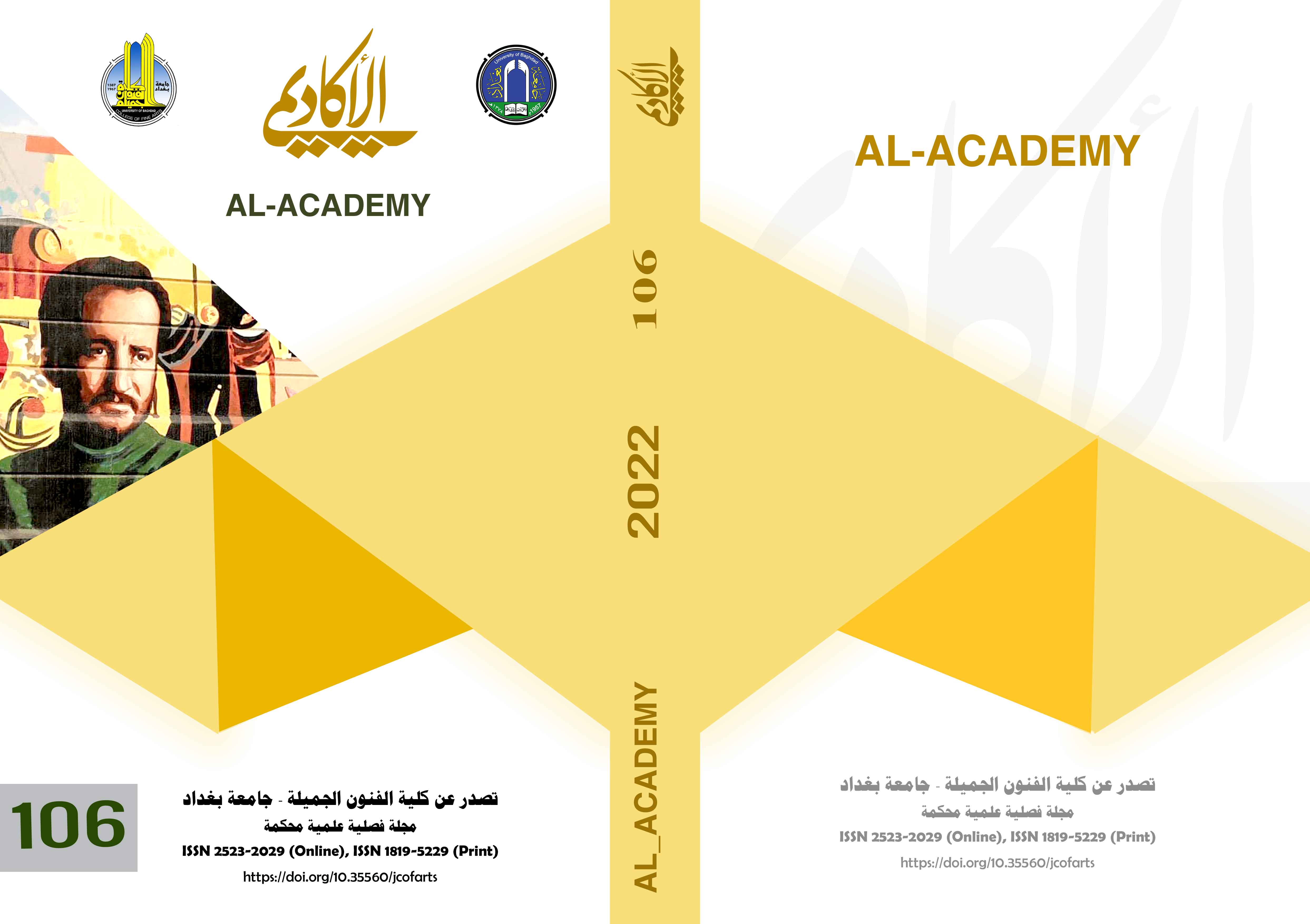Visual effects in contemporary animation design
DOI:
https://doi.org/10.35560/jcofarts106/407-430Keywords:
Visual effects , animation designAbstract
The current research, tagged (visual effects in contemporary animation design), discussed visual effects, creative imagination, design idea, and the employment of animation in graphic design using typographic units. Through the methodological framework, the researcher found his research problem clear through the following question: What are the visual effects in animation design contemporary?
The importance of the research is seeking to clarify the design concepts that will enhance the concept of technical development of software, the active contribution in consolidating the idea of dealing with those influences and modalities that guarantee positive results in achieving the applied aspects in their functional and aesthetic dimensions.
The aim of the research is to identify the visual effects in contemporary animation design.
The objective limits of research is the study of visual effects in the design of contemporary animation. The spatial limitation is the visual effects used in MBC Iraq.
In the period from 2019-2021. The most important terms mentioned in the title were identified. The theoretical framework in the first topic dealt with the concept of visual effects and creative imagination in the design idea.
The second topic is the employment of animation and typographic units in graphic design
The most important indicators that resulted from the theoretical framework were concluded, and the researcher did not find a previous study that was close to or converged with the current study.
1- The sample appeared expressive of visual effects in animation through imagination, idea and design.
2- The designers used the typographic units appropriately (image, shapes and text).
3- Animation was used to establish the functional and aesthetic dimension
4- The design elements and foundations had an important and effective role in distributing the design vocabulary and exploiting the dynamic space.
And he drew conclusions from it
1- The imagination and design ideas were clear through the role of the visual effect in the moving partitions
2- The use of vocabulary and typographic elements was expressive of the intellectual and aesthetic content
3- The rhythmic and dynamic organization of the elements and the method of their distribution had a role in creating a high-performance visual effect
The researcher recommended taking advantage of the results of this study to enhance the visual effects in the design of contemporary animation, which has taken a large part in the fields of making introductions and visual breaks to focus the importance of graphic design in society.
The researcher suggested conducting studies on the following:
1- Implications of graphic techniques on visual effects
3- Functional data for visual effects in graphic design
References
Ahmad Kamel & Majdi wahba. (1973). Cinematic Art Dictionary. Cairo: The Egyptian Book Authority.
& Corkett Shaoqiang Wang. (2020). Optical Illusions In Graphic Design. China: Prestel.
Abd al-Ridha Daoud Bahiya. (1997). Constructing Grammar as Content Semantics in Linear Formations, PhD thesis, College of Fine Arts. Baghdad: Baghdad University.
Afif Bahnasi. (1972). Aesthetics at Abi Hayyan Tawhidi. Baghdad: Public Culture School, Thunayan Press.
Ahmad Dawood Murad. (2017). The role of graphic animation in the design of advertisements, knowledge of the Jordanian sports channel. Amman: Middle East University, College of Architecture and Design.
Ahmad N. (2021). Effects. Baghdad: Althakira.
Ahmad Sami Albastawisi. (2019). Employing plastic values of architecture in scenes of science fiction films: an analytical study, an unpublished Ph.D. thesis. Egypt: Helwan University, College of Fine Arts.
Ahmed Omar Mohamed. (2017). The psychology of graphic design (advertising design) for new media. Sharjah: International Design Journal.
Alaa Bahauddin Awad. (2020). The role of visual and sound effects in foreign science fiction films and their reflection on the aesthetics of audience reception. South Valley University - Egypt: Scientific Journal of Media Research and Communication Technology.
atz steven. (2005). Film directing shot by shot. UAE: University Book House.
Ayyub ibn Musa al-Kafouri Abu al-Balqa’. (1998). Al-Kuliat 2nd edition. Beirut: Alrisala Foundation.
Badria Mohamad Hasan AlHaj Faried. (2003). The dialectic of the relationship between the functional structure and the aesthetic structure in interior design. PhD thesis. Baghdad: Baghdad University - College of Fine Arts.
baianat. (2020). baianat. www.baianat.com: https://www.baianat.com/ar/books/graphic-design/design-elements
barbara bear captiman. (1976). American Trade Mark. New york.
Basim Abas Alobaidi. (2014). The brand has its functional and expressive connotations. Baghdad: Waves for printing, publishing and distribution.
BMC-EM. (10 April, 2017). bmcemblog. https://bmcemblog.wordpress.com: https://bmcemblog.files.wordpress.com/2017/04/lo515.pdf
Clark Frank. (1979). Special Effects in Motion Pictures , Second Edition. New york.
Deopold van Dalen. (1977). Find in education and science curricula psychology. Cairo: The Anglo-Egyptian Library.
Dina Muhammad Enad. (2010). What is the underlying system in the act of designing commercial advertisements? Baghdad: Baghdad University - College of Fine Arts.
Donald A. Hudgins. (2008). Rhythm and Views: A Compilation of Eight Projects Including Scoring, Video Production and Motion Graphic Design. Ohio: ETD center.
Ernest Fisher. (1971). Art necessity Translated by Asad Halim. Cairo: Dar Al-Nahda.
G., & Harris, P. (n.d.). Ambrose. (2015). Basics of graphic design. Jordan: Jabal Amman Publishers.
George Latif Sidhom. (2020). TV advertising and visual effects. Cairo: Al-Arabi for publishing and distribution.
Gerges Michel Gerges. (2005). Dictionary of education terms, first edition. Beirut: Nahda House.
Gerrald Millerson. (1985). The Technique of Television Production, Eleventh Edition. London: Focal Press.
Hadi Noman Al-Hiti. (1988). kids culture. Kuwait: National Council for Culture, Arts and Letters.
I. & Bear P. Crook. (2016). Motion graphics: principles and practices from the ground up. (1st ed). London: Bloomsbury Publishing Plc.
Ibrahim Bakhti. (2015). Methodological guide for the preparation of scientific research. Algeria: Kasdi Merbah University.
Iyad Hussein Abdullah. (2008). Art Design Theoretical Philosophy. Sharjah: House of Culture and Media.
Iyad Hussein Abdullah. (2008). The art of design, part 3. Sharjah: Department of Culture and Media.
Jamal al-Din Muhammad Makram Ibn Manzoor. (1956). Lisan Al-Arab Part3. Beirut: Dar Sader.
Jamil Saliba. (1971). The Philosophical Lexicon in Arabic, French and English Words, 2nd Edition. Beirut: The Lebanese Book House.
Jerome Stollnitz. (1974). Art criticism is an aesthetic and philosophical study. Cairo: Ain Shams Press.
Khalil Ahmed Khalil. (1995). Dictionary of Linguistic Terms, Arabic, French, English, Scientific Dictionaries Series (5). Beirut: Lebanese Alfikr House.
Mohamad Abdulmoen Khan. (2008). Arab legends before Islam. Cairo: Egypt Publishing House.
Mohammed Mouawad. (2014). Modern trends of the effects of television on children - children and the third father. Algeria: Modern Alfikr House.
Mona Katea Al-Awadi. (1996). Design trends for Iraqi cotton fabrics. Baghdad: Baghdad University, College of Fine Arts.
Muhammad Munir Hijab. (2004). Media Dictionary, first edition. Beirut: Alfajr House.
Nadia Khalil Al-Azzawi. (2002). Unity and diversity in the design systems of the printed advertisement, a master's thesis submitted to the University of Baghdad. Baghdad: College of Fine Arts.
Nasreddin bin Ghoneisa. (2011). Semiotics chapters, 1st edition. Irbid: Modern book world for publishing and distribution.
Nawal Mohamed Saleh. (2012). Cinematography technology from the traditional era to the digital era. Sultanate of Oman: National translation project.
Nicholas Weed. (1988). Optical illusions art and science. Baghdad: Dar Al-Ma'moun for translation and publishing.
R. Poulin. (2018). The language of graphic design : an illustrated handbook for understanding fundamental design principles. New York: Rockport Publishers.
Radwan Kodmani. (2012). Semiology and Semiotics. Electronic Aesthetics Journal.
Ramsey the Arab. (2008). graphic design. Amman.
Rania Mamdouh Sadek. (2012). TV commercial design and production, 1st edition. Amman: Dar Osama for publication and distribution.
Robert Gillam Scott. (1980). Basics of design. Cairo: Dar Nahdet Misr for printing and publishing.
Rudd Richarad and others. (1967). Content analysis of communications. New York: Macmillan.
Saleh bin Hamad Al-Assaf. (2010). An introduction to research in the behavioral sciences. Riyadh: Zahra House.
Samar Rouhi. (22 5, 2012). Imagination and imagination in children's literature. 2 2, 2021، Star Times Forums: http//:www.startimes.com
Samia Ahmed Saad. (1985). Theatrical semantics. Alam Alfikr Magazine, Part 1.
Scott squires. (2010 ). The VES Handbook of visual Effects. USA: focal press.
Shaker AbdelHamid. (2008). Visual Arts and Perceptual Genius. Cairo: Egyptian General Book Authority.
Shaker AbdelHamid. (2009). Imagination from the cave to virtual reality. Kuwait: Almarifa world.
Shereen Ehsan Sherzad. (1985). Principles in Art and Architecture. Baghdad: Alyaqada alarabia Library.
Ted Hondrich. (2003). The Oxford Handbook of Philosophy, translated by Naguib Al-Hasadi. Libya: National Research and Development Office.
William Fleming. (2000). Arts and ideas. New York: Rinehart and Winston ine.
Downloads
Published
Issue
Section
License
Copyright (c) 2022 Akram jirjis Nehme, Ahmed Naima Obaid

This work is licensed under a Creative Commons Attribution 4.0 International License.













